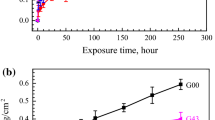Abstract
Oxidation of five nickel-chromium-aluminum alloys with yttrium additions of between 0.005 and 0.7wt.% has been studied in the temperature range 800–1200°C in oxygen at pressures of 1, 10, and 720 Torr. The yttrium additions improve the oxidation behavior of the nickel-chromium-aluminum alloys, and generally an addition of 0.1 or 0.2 wt.% yttrium gives the best improvement in the oxidation resistance. In this case, the oxidation kinetics indicate asymptotic approach toward zero scale growth with time. This is suggested to be caused by the formation of subgrains in the alloy which (a) provide enhanced diffusion of aluminum to the surface and (b) increase the number of oxide nucleation sites. Preferred oxidation of aluminum occurs, resulting in the formation of an α-Al 2O3 layer. Additions of more than 0.3 wt.% yttrium result in preferential grain boundary oxidation and a convoluted alloy-oxide interface. This effect, “key-on effect” along with the formation of an aluminum and yttrium double oxide, produces increased oxide adherence for these alloys.
Similar content being viewed by others
References
I. A. Kvernes and P. Kofstad,Trans. AIME 3, 1511 (1972).
F. H. Scott and G. C. Wood,Corros. Sci. 11, 799 (1971).
E. Hornbogen,Z. Metall. 6, 293 (1964).
R. M. Doerr, J. W. Jensen, and C. C. Myers, R. Bureau of Mines, Report of Investigations 6800 (1966).
A. H. Seybolt,Corros. Sci. 6, 263 (1966).
I. A. Kvernes and W. Tripp, paper presented at E.C.S., Commemorative Symposium on Oxidation of Metals, 1970.
G. E. Wasilewski, Oxidation of Ni and Co superalloys, G.E. Co. R68AEC141, Jan. 1968.
A. M. Beltran, paper presented at Corrosion Meeting, Amsterdam, 1969.
E. J. Felton,J. Electrochem. 108, 490 (1961).
G. C. Wood and J. Baustead,Corros. Sci. 8, 719 (1968).
J. M. Francis and W. H. Whitlow,Corros. Sci. 5, 701 (1965).
C. S. Wukusick and J. F. Collins,Mat. Res. Stand. 4, 637 (1964).
J. K. Tien and F. S. Pettit,Trans. AIME 3, 1587 (1972).
J. E. Antill and K. A. Peakill,J. Iron Steel Inst. 105, 1136 (1967).
G. C. Wood,Werkstoffe U Korros. 6, 491 (1971).
H. Pfeiffer and G. Sommer,Z. Metall. 4, 326 (1966).
D. Turnbull and R. E. Hoffman,Acta Met. 2, 419 (1954).
M. J. Fleetwood,J. Inst. Met. 94, 218 (1966).
B. Wenderott,Z. Metall. 56, 63 (1965).
M. S. Seltzer and B. A. Wilcox, submitted toMet. Trans.
Author information
Authors and Affiliations
Additional information
Part of the work was carried out during the author's stay at Aerospace Research Laboratories, Wright-Patterson Air Force Base, Dayton, Ohio 45433, USA. It was sponsored in part by the Air Force Materials Laboratory, Research and Technology Division, AFSC, through the European Office of Aerospace Research, OAR, U.S. Air Force.
Rights and permissions
About this article
Cite this article
Kvernes, I.A. The role of yttrium in high-temperature oxidation behavior of Ni-Cr-Al alloys. Oxid Met 6, 45–64 (1973). https://doi.org/10.1007/BF00612046
Received:
Revised:
Issue Date:
DOI: https://doi.org/10.1007/BF00612046




